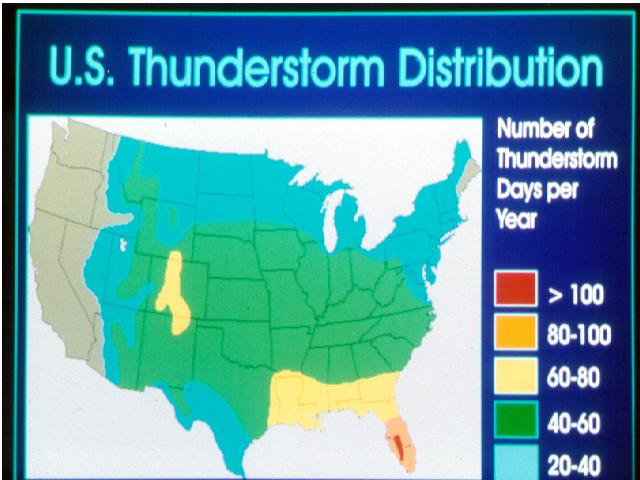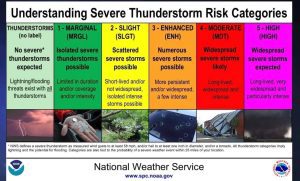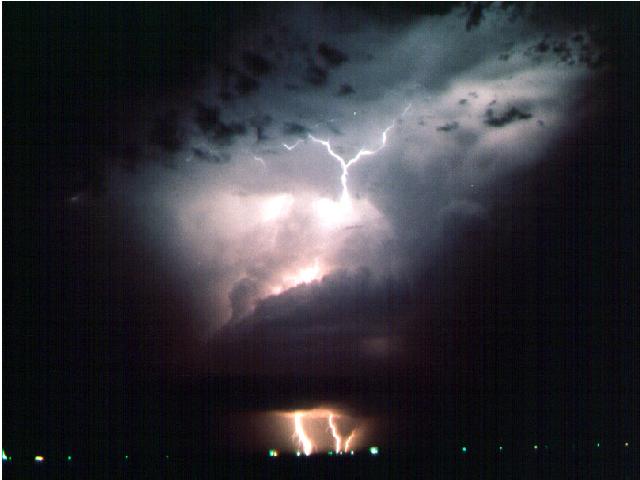 THUNDERSTORM HAZARDS
THUNDERSTORM HAZARDSNearly 1,800 thunderstorms are occurring at any one moment around the world. Approximately 16 million thunderstorms occur each year around the world and 100,000 occur in the U.S. Of those 100,000 storms, only about 10% are severe. The National Weather Service defines a severe thunderstorm as one which produces winds of 58 mph or greater, 3/4 inch hail or larger or tornadoes.
Areas over west central Florida experience more thunderstorms per year on average than any other location in the U.S. with > 100 per year (See graph above). Key West averages 64 days per year with thunderstorms with August averaging 14 and July 13 as the 2 most active months for thunderstorms in the Keys. Thunderstorms can occur in any month of the year in the Keys.
Thunderstorms need 3 ingredients to form; moisture, especially in the lower levels, unstable air, cold air over warm air, and a source of lift such as a cold front, sea breeze or low level outflow boundary from a cluster of thunderstorms. The Keys often have the first 2 ingredients but sometimes lack the necessary lift. This is one reason why the Keys do not average as many thunderstorms or as much rainfall as the Florida mainland.
With a high frequency of thunderstorms in the Keys, it is important to remember that all thunderstorms can be dangerous. Lightning occurs with all thunderstorms and is very dangerous. Most lightning strikes are cloud to cloud but some are cloud to ground (pictured above) and these are the ones which kill about 93 people/year in the U.S.
Lightning is caused by the action of rising and descending air within a thunderstorm that separates positive and negative charges. Water and ice particles in the thunderstorm also affect the distribution of electrical charge. Lightning results from the buildup and discharge of electrical energy between positively and negatively charged areas.
The average lightning strike has enough energy to light a 100 watt bulb for 3 months. The air near a lightning strike is heated to near 50,000 F, hotter than the surface of the sun. The rapid heating and cooling of the air near the lightning channel causes a shock/sound wave that results in thunder. Most lightning deaths and injuries occur when people are caught outdoors.
The following are some facts and myths about lightning.
MYTH: If it is not raining, then there is no threats from lightning.
FACT: Lightning often strikes outside of heavy rain and may occur as far as 10 miles away from rainfall.
MYTH: Rubber soles of shoes and tires on a car will protect you from being struck by lightning.
FACT: These items provide NO protection from lightning. However, you are much safer inside a vehicle than outside. The steel frame of a hard topped vehicle provides increased protection if you are not touching metal.
MYTH: “Heat Lightning” occurs after very hot summer days and poses no threat.
FACT: “Heat lightning” is actually lightning which occurs in a distant thunderstorm that is too far away to hear its associated thunder.
Thunderstorms produce other hazards as well. The number 1 thunderstorm killer is flash flooding. Flash flooding from thunderstorms kills about 140 people/year in the U.S. Fortunately, the Keys do not experience major problems with freshwater flooding due to the lack of rivers, creeks etc. etc., small land masses and flat terrain.
Another hazard from thunderstorms is large hail. Large hail is generally 1 inch in diameter or larger and can cause a great deal of damage. Hail damage in the U.S. averages about $1 billion per year. Large hailstones can fall at speeds faster than 100 mph. The Florida Keys rarely experience hail from thunderstorms, although it is possible. Golf ball size hail was reported in Marathon in February 1998 during the “Groundhog Day” storm.
Straight line winds are responsible for most thunderstorm wind damage. On land, wind gusts from thunderstorms usually need to be > 50 mph to cause damage, however, over water, wind gusts of 30 mph (26 knots) or greater can be dangerous to small boats. One type of straight line wind, a downburst, can cause damage similar to tornadoes and is extremely dangerous to aviation take offs and landings. A downburst is a small area of rapidly descending air beneath a thunderstorm. This air can cause damaging winds in excess of 100 mph. Downbursts are associated with severe thunderstorms and not all thunderstorms produce downbursts.
Tornadoes are the most dangerous and damaging aspect of severe thunderstorms. Wind speeds of tornadoes can reach to near 300 mph and cause an average of 80 deaths and 1,500 injuries per year in the U.S. Most fatalities from tornadoes occur in mobile homes and in automobiles.


